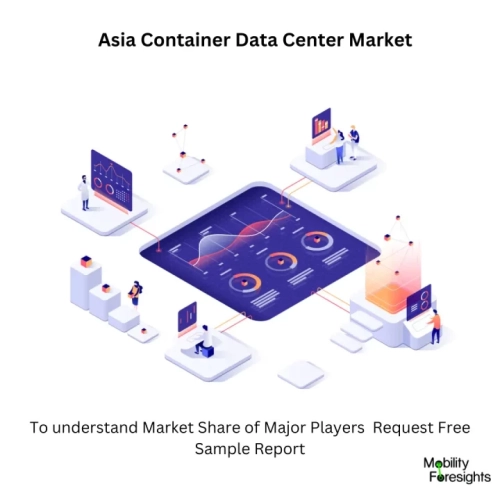
- Get in Touch with Us

Last Updated: Apr 25, 2025 | Study Period:
The Asia container data center market is experiencing robust growth due to the increasing demand for scalable, portable, and energy-efficient data center solutions. With rapid advancements in cloud computing, IoT, and edge computing, containerized data centers are gaining traction as an efficient alternative to traditional brick-and-mortar data centers. These pre-fabricated solutions offer quicker deployment, reduced operational costs, and enhanced flexibility, making them an attractive option for companies looking to expand their digital infrastructure without the constraints of physical locations.
Technological innovations such as liquid cooling systems and modular designs are revolutionizing the container data center space. These developments enable companies to operate data centers in diverse environments, from urban centers to remote locations. However, challenges persist, particularly in terms of regulatory compliance and security concerns, as containerized solutions must meet varying standards across different countries in the region. Overall, the marketâs growth trajectory is shaped by the increasing reliance on data and the need for efficient, flexible solutions to manage it.
The Asia container data center market represents a growing segment within the larger data center industry, focusing on providing portable, scalable, and energy-efficient solutions for data storage and processing. These containerized solutions are designed to meet the increasing demand for fast deployment, lower capital expenditure, and operational flexibility, making them an attractive choice for businesses across various sectors.
Container data centers are typically classified into several types, including all-in-one containers, customized containers, and modular containers. Each type offers varying degrees of customization, performance, and scalability, catering to the specific needs of companies ranging from small startups to large enterprises.
Applications of container data centers span multiple industries, including telecommunications, IT and cloud services, healthcare, and government institutions. These portable data centers are particularly beneficial in edge computing environments, where data processing needs to happen close to the source, reducing latency and improving real-time data analysis.
Despite their benefits, container data centers face challenges such as high initial costs, regulatory hurdles, and security concerns. However, their ability to be quickly deployed in remote or difficult-to-access locations, along with their energy efficiency, makes them a viable solution for companies looking to future-proof their data infrastructure.
The Asia container data center market was valued at approximately USD 4.5 billion in 2023, with projections suggesting it will reach around USD 9.5 billion by 2030. This represents a CAGR of 15.7% over the forecast period. Key drivers for this growth include increasing demand for cloud services, the rollout of 5G networks, and the rise of edge computing. Countries like China, India, and Japan are expected to lead the market, with significant investments in IT infrastructure and smart city projects. Additionally, the energy efficiency of container data centers is expected to play a critical role in their widespread adoption, particularly as sustainability becomes a core concern for businesses.

The container data center market in Asia is influenced by several notable trends. One of the most significant is the push towards edge computing, which requires data centers to be deployed closer to end users. Containerized data centers are ideal for this, providing a scalable solution that can be easily set up in a variety of locations.
Another trend is the growing importance of energy efficiency. With sustainability becoming a key focus for businesses, many companies are opting for container data centers with advanced cooling systems, such as liquid cooling, and are exploring the use of renewable energy sources to power these facilities. The increasing reliance on 5G technology and IoT is further driving the demand for flexible data center solutions, while advancements in AI and machine learning are transforming how data centers are managed and maintained.
| Sl. No. | Topic |
| 1 | Market Segmentation |
| 2 | Scope of the Report |
| 3 | Research Methodology |
| 4 | Executive Summary |
| 5 | Key Findings |
| 6 | Market Size, Dynamics, and Forecast by Geography, 2024-2030 |
| 7 | Market Size, Dynamics, and Forecast by Product Type, 2024-2030 |
| 8 | Market Size, Dynamics, and Forecast by End User, 2024-2030 |
| 9 | Competitive Landscape |
| 10 | Leading Players |
| 11 | Company Profiles |
| 12 | Market Share of Vendors, 2023 |
| 13 | New Product Development in Asia Container Data Center Market |
| 14 | Technological Developments in Container Data Centers |
| 15 | Major Projects Utilizing Container Data Centers |
| 16 | Regulations, Standards, and Incentives, by Region |
| 17 | Asia Container Data Center Production Footprint - 2023 |
| 18 | Unmet Needs and Opportunities |
| 19 | Government Initiatives and Their Impact |
| 20 | Conclusion |